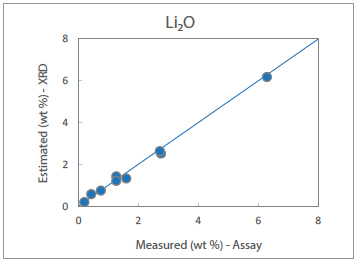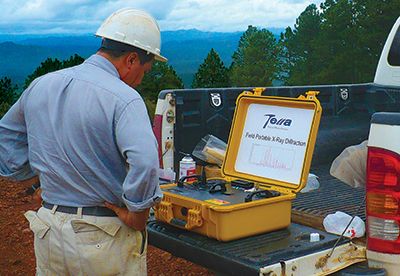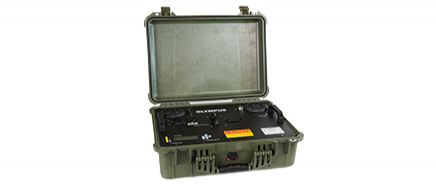Exploration, Mining, and Extraction in Pegmatite Deposits
Olympus portable X-ray diffractometers (pXRD), such as the TERRA® analyzer, provide geologists and metallurgists with quantitative mineralogy in near real time, across all mineral species. Exploration geologists can use the TERRA analyzer to make more informed decisions in the field. Metallurgists can use pXRD to obtain the information needed to develop more effective blending strategies and optimize processing and refining techniques to yield better lithium recoveries.
Benefits of Olympus pXRDOlympus’ innovative pXRD analyzers offer many advantages:
|
Exploration
Lithium can be hosted within a range of minerals in pegmatitic rocks. A list of the main lithium-bearing minerals is provided in Table 1. Olympus pXRD can rapidly identify and quantify all these lithium-bearing minerals, irrespective of their reflectance. Quantitative mineralogy can then be back calculated to chemistry to provide geologists with excellent estimates of lithium concentrations while in the field (Figure 1). Rather than waiting days or weeks for lithium assay data from a laboratory, exploration geologists can use Olympus pXRD to make the following types of informed decisions in near real time:
 Figure 1: Comparison between Li2O measured by a laboratory compared to estimates from quantitative XRD. |
Table 1. Main Lithium-bearing minerals and chemistry (source: webmineral.com). |
Processing and Extraction
Knowing Li2O concentration is important, but a knowledge of the lithium-bearing phases present (and their quantities) is often more important. Lithium can be easily extracted from some minerals yet difficult to near impossible to extract from others. With access to quantitative mineralogy, metallurgists are able to develop more appropriate blending strategies and optimize their processes accordingly.
XRD can also be used to identify gangue minerals that can downgrade lithium concentrates. For example, gravity separation is a metallurgical process that can be used to concentrate spodumene. As other non-lithium-bearing pyroxene minerals have a similar specific gravity to spodumene, it is important to identify and quantify other pyroxene minerals.
Data Quality
Portable Olympus XRD analyzers can provide data equivalent to that of laboratory XRD instruments. To illustrate this, results of quantitative XRD analysis from a lithium-bearing pegmatite were back calculated to chemistry and the results compared to laboratory chemical assay (Table 2 and Figures 1 and 2).
| SiO2 | Li2O | Al2O3 | Na2O | K2O | |||||
| XRD | Assay | XRD | Assay | XRD | Assay | XRD | Assay | XRD | Assay |
| 79.37 | 75.59 | 1.33 | 1.57 | 13.29 | 15.00 | 3.98 | 3.45 | 2.04 | 2.42 |
| 80.18 | 75.07 | 4.29 | 4.19 | 15.20 | 17.13 | 0.33 | 0.65 | ||
| 78.39 | 74.08 | 2.66 | 2.70 | 14.80 | 16.54 | 2.17 | 2.34 | 1.99 | 1.88 |
| 79.26 | 75.44 | 1.22 | 1.30 | 13.18 | 15.08 | 3.83 | 3.57 | 2.51 | 2.82 |
| 70.98 | 68.53 | 6.18 | 6.28 | 22.15 | 22.57 | 0.53 | 0.47 | 0.17 | 0.44 |
| 76.01 | 74.20 | 0.59 | 0.43 | 14.18 | 14.95 | 2.37 | 3.22 | ||
| 74.01 | 75.90 | 2.53 | 2.76 | 16.50 | 17.30 | 1.83 | 1.25 | ||
| 73.62 | 73.40 | 1.44 | 1.27 | 14.74 | 16.70 | 5.68 | 5.32 | ||
| 76.66 | 72.50 | 0.22 | 0.19 | 12.67 | 14.30 | 4.35 | 4.42 | ||
| 75.04 | 74.70 | 0.75 | 0.75 | 15.58 | 15.45 | 2.09 | 1.92 | ||
Table 2. Comparison between Si2O, Li2O, Al2O3, Na2O, and K2O measured by a laboratory compared to estimates from quantitative XRD.

Figure 2. Comparison between Al2O3, SiO2, Na2O and K2O measured by a laboratory compared to estimates from quantitative XRD.


